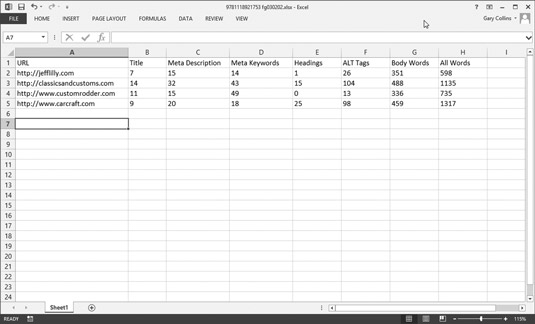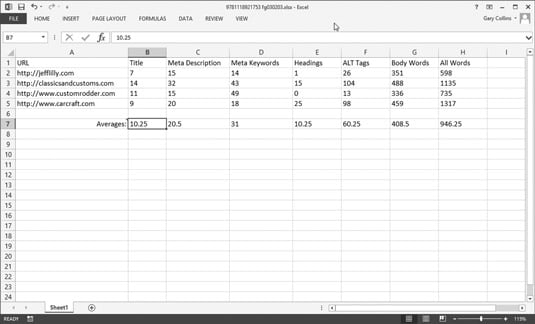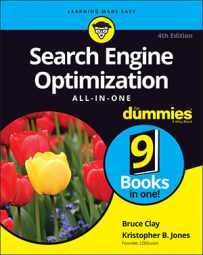The Single Page Analyzer tool can help you improve your site for SEO. It tells you what a web page’s keywords are and computes their density. Keyword density is a percentage indicating the number of times the keyword occurs compared to the total number of words in the page.
When you run a competitor’s page through the Single Page Analyzer, it lets you analyze the on-page factors that help the web page rank well in search engines. Subscribers to SEOToolSet Pro can simply run the Multi Page Analyzer, but for those just using the Single Page Analyzer included with a free subscription to SEOToolSet Lite, there’s a step-by-step process to build a comparison tool for yourself.
Because you’re going to run the Single Page Analyzer report for several of your competitors’ sites and work with some figures, it’s time to grab a pencil and paper. Better yet, open a spreadsheet program such as Microsoft Excel, which is a search engine optimizer’s best friend. Microsoft Excel allows you to arrange and compare data in rows and columns, similar to a paper ledger or accounts book.
Here’s how to set up your spreadsheet:
In Excel, open a new spreadsheet and name it Competitors.
Type a heading for column A that says URL or something that makes sense to you.
In this first column, you’re going to list your competitors’ web pages, one per row.
Under column A’s heading, type the URL (the web page address) for each competing web page, one address per cell.
You can just copy and paste the URLs individually from the search results page if that’s easier than typing them.
Now you’re ready to run the Single Page Analyzer report for each competitor. You can use the free version of this tool available through SEOToolSet.com. Here’s how to run the Page Analyzer:
Go to SEOToolSet’s Free Tools.
In the Single Page Analyzer section, enter a competitor’s URL in the Page URL text box.
Click the Run Page Analyzer button and wait while the report is prepared.
The whole report contains a lot of useful information, but what you’re trying to gather now are some basic counts of the competitor’s on-page content. So you want to zero in on a row of data that begins with “Used Words,” about halfway down the report, which shows a quick summary of some important page content counts.

Next, you’re going to record these summary counts in your spreadsheet. You may want to create some more column headings in your spreadsheet, one for each of the following seven items:
Title: Shows the number of words in the page’s Title tag (which is part of the HTML code that gets read by the search engines).
Meta Description: Shows the number of words in the description Meta tag (also part of the page’s HTML code).
Meta Keywords: Shows the number of words in the keywords Meta tag.
Headings: The number of headings in the text (using HTML heading tags).
ALT Tags: The number of Alt attributes (descriptive text placed in the HTML for an image file) assigned to images on the page.
Body Words: The number of words in the page text that’s readable by humans.
All Words: The total number of words in the page content, including onscreen text plus HTML tags, navigation, and other.
Now that you have the first several columns labeled, start typing in the counts from the report for this competitor. Run the Single Page Analyzer report for each of your other competitors’ URLs. You’re just gathering data at this point, so let yourself get into the rhythm of running the report, filling in the data, and then doing it all over again. After you’ve run the Single Page Analyzer for all your competitors, you should have a spreadsheet similar to this.

After you gather some raw numbers, what can you do with them? You’re trying to find out what’s “normal” for the sites that are ranking well for your keyword. So far you’ve gathered data on eight different factors that are part of the search engines’ ranking systems. Now it’s just simple math to calculate an average for each factor.
You can do it the old-fashioned way, but Excel makes this super-easy if you use the AutoSum feature. Click to highlight a cell below the column you want to average and then click formulas, then AutoSum, and then Average. When you select Average, Excel automatically selects the column of numbers above the field containing the average calculation, so press Enter to approve the selection. Your average appears in the highlighted field.

You can create an average for each of the columns in literally one step. If you look at the outlined cell to the right of the Average cell, notice the slightly enlarged black square in the lower-right corner. Click and drag that little square to the right, all the way across all the columns that have data, and then let go. Averages should now display for each column because you just copied the AutoSum Average function across all the columns where you have data.
You can next run a Single Page Analyzer on your own website and compare these competitor averages to your own figures to see how far off you are from your target. For now, just keep this spreadsheet handy and know that you’ve taken some good strides down the SEO path of information gathering.
A Multi Page Analyzer makes short work of analyzing all your competitors’ web pages at once. Unfortunately, this usually requires that you subscribe to an SEO tool vendor that provides this and many other worthwhile tools for a fee, including the SEOToolSet.

